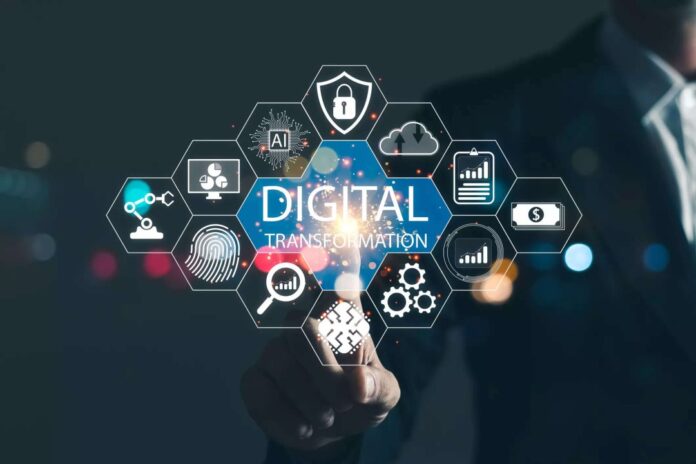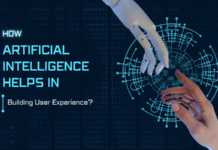As we continue to move into the new year, it’s essential to stay on top of the digital transformation trends that are shaping the future of business. With all the new technologies being introduced, it can be hard to keep up with the changes. That’s why we’ve put together a guide to the top trends for 2023 that will help you navigate digital transformation.
From understanding the impact of artificial intelligence to leveraging 5G networks, this guide will cover the ten key trends that are transforming the way businesses operate. With the right understanding and knowledge of these trends, you’ll be prepared to take advantage of the opportunities that come with digital transformation. Let’s first explore some interesting facts abut digital transformation:
- AI spend in the retail industry is expected to reach $20.05 billion by 2026, a compounded annual growth rate of 39% since 2019.
- 80% of retail executives expect their companies to adopt AI-powered intelligent automation by 2027.
- Juniper Research reports a growth of 230% in machine learning spending between 2019 and 2023.
- 5G subscriptions are forecast to increase to 2.8 billion by 2024
- 5G subscriptions are expected to reach 5.9 billion by 2027
- The market is expected to grow at a CAGR of 14.8% and is anticipated to reach around USD 220.94 Billion by 2026.
- The wellness wearables market is expected to reach $27 billion by 2022.
So, get ready to explore the world of digital transformation and get ready to shape the future of your business in the upcoming year!
The Rise of Artificial Intelligence
Artificial Intelligence (AI) is not just a buzzword anymore – it’s a game-changer. As we step into the future, AI is shaping the world around us in ways we never thought possible. From self-driving cars to virtual assistants, AI is transforming the way we live and work.
One of the most significant advancements in AI is its ability to analyze vast amounts of data and provide valuable insights. This is precisely useful in industries such as healthcare and finance, where AI-powered algorithms can detect patterns and make predictions that can save lives or optimize financial portfolios. AI is like a super-powered brain that can process information at lightning speed, enabling businesses to make better decisions and achieve unprecedented efficiency.
But AI is not just about robots taking over the world – it’s about enhancing our lives and augmenting human capabilities. It can automate repetitive tasks, freeing up time for employees to focus on more complex and creative work. This can lead to increased job satisfaction and innovation within organizations.
AI is also revolutionizing customer experiences. Chatbots and virtual assistants are becoming more sophisticated, able to understand natural language and provide personalized responses. Imagine having a conversation with a customer service representative who knows your preferences and can help you with your queries instantly. AI is bringing businesses closer to their customers, creating a seamless and personalized experience.
Of course, with all its advancements, AI raises ethical concerns. We need to ensure that AI is used responsibly and transparently. We must consider the potential biases that AI systems can have and work towards eliminating them. The ethical implications of AI are a topic of ongoing discussion and will continue to be a key focus in the years to come.
As AI continues to evolve, we can expect even greater breakthroughs in the future. From healthcare advancements to smart cities, AI is set to revolutionize every aspect of our lives. It’s an exciting time to be alive and witness the rise of artificial intelligence. So, buckle up and get ready for the AI revolution – it’s here to stay, and it’s only getting started.
Blockchain Technology and Its Impact
Blockchain technology has emerged as a groundbreaking innovation that is disrupting various industries and reshaping the way we conduct business. With its decentralized and transparent nature, blockchain is revolutionizing everything from finance to supply chain management.
One of the key impacts of blockchain technology is in the financial sector. Blockchain allows for secure and transparent transactions, eliminating the need for intermediaries and reducing costs. This technology has the potential to make financial transactions more efficient and accessible to people around the world. Imagine being able to send money instantly and securely to anyone, regardless of their location or the traditional banking system. Blockchain is bringing financial services to the unbanked and underserved populations, empowering them economically.
Beyond finance, blockchain is transforming supply chain management. With its ability to create an immutable and transparent record of transactions, blockchain ensures the integrity of the supply chain and reduces the risk of fraud or counterfeit products. From farm to table, blockchain technology can track the journey of goods, ensuring that they meet quality and safety standards. This creates a level of trust and accountability in the supply chain that was previously unimaginable.
Another area where blockchain technology is making a significant impact is in the healthcare industry. Blockchain can securely store and share patient data, enabling healthcare providers to access accurate and up-to-date medical records. This can lead to more efficient diagnoses and treatments, ultimately improving patient outcomes. Additionally, blockchain technology can facilitate clinical trials and research by securely and transparently storing data.
As we continue to explore the potential of blockchain technology, it’s essential to address the challenges and ethical considerations that come with it. Issues such as privacy, scalability, and energy consumption need to be addressed to ensure that blockchain technology is used responsibly and sustainably.
Blockchain technology is still in its early stages, but its potential for transformative change is undeniable. As we navigate the future of digital transformation, blockchain will continue to shape the way we conduct business, bringing transparency, security, and efficiency to various industries. Embrace this technology with an open mind and prepare to witness the positive impact it will have on our world.
The Growing Importance of Cybersecurity
In today’s interconnected world, cybersecurity has become more critical than ever. With the increasing reliance on digital technology, businesses are constantly at risk of cyber threats that can compromise sensitive data, disrupt operations, and damage their reputation. As the cyber threat landscape continues to evolve, organizations must prioritize cybersecurity to protect themselves and their customers.
One of the key reasons why cybersecurity is growing in importance is the rise in cyber attacks. Hackers and cybercriminals are becoming more sophisticated, employing advanced techniques to breach security systems and steal valuable information. From phishing attacks to ransomware, businesses face a constant barrage of threats that can have devastating consequences.
The consequences of a cybersecurity breach can be severe. Beyond financial losses, businesses can suffer reputational damage that takes years to recover from. Customers today are more aware of cybersecurity risks and are less likely to trust a company that has experienced a breach. Protecting customer data is not just a legal requirement but also a crucial aspect of maintaining trust and loyalty.
Cybersecurity is not just about protecting data and systems; it’s also about protecting people. Cyber attacks can result in identity theft, financial fraud, and even physical harm in some cases. By prioritizing cybersecurity, businesses can ensure the safety and well-being of their employees, customers, and partners.
The Emergence of 5G
The world of connectivity is about to be revolutionized with the emergence of 5G. Get ready to experience lightning-fast speeds, low latency, and unparalleled connectivity that will transform the way we live, work, and play. With 5G, you can precisely say goodbye to buffering and hello to instant streaming of high-definition content. Imagine downloading an entire movie in a matter of seconds or having a lag-free gaming experience that puts you right in the action. But 5G is not just about faster speeds; it’s about unlocking a world of possibilities.
From self-driving cars to smart cities, 5G will enable a new era of innovation and efficiency. It will power the Internet of Things, allowing for seamless connectivity between devices and paving the way for a truly connected world. And let’s not forget about the impact of 5G on industries such as healthcare and manufacturing. With its ultra-low latency, 5G will enable real-time monitoring and remote surgeries, revolutionizing the way we deliver and receive healthcare. The possibilities are endless, and the future is bright with 5G. So, get ready to embrace the next generation of connectivity and unlock a world of endless possibilities. The future is here, and it’s called 5G.
Voice Assistants and Natural Language Processing
Voice assistants and natural language processing (NLP) are transforming the way we interact with technology and bringing a new level of convenience to our daily lives. These AI-powered virtual assistants, such as Amazon’s Alexa, Apple’s Siri, and Google Assistant, have become our helpful companions, ready to answer questions, play music, set reminders, and even control smart home devices with just a voice command.
The beauty of voice assistants lies in their ability to understand and interpret natural language. Instead of typing or tapping on screens, we can simply speak our commands or queries, and the voice assistant will do the rest. This not only saves us time but also provides a more intuitive and hands-free experience.
But it’s not just the convenience factor that makes voice assistants so fascinating. It’s the human-like interactions and the emotional connection that they can create. Voice assistants are becoming more conversational, with the ability to engage in casual chats, tell jokes, and even provide emotional support. It’s like having a friendly companion by your side, ready to lend an ear and make you smile.
Moreover, NLP is enabling voice assistants to understand context and intent. They can recognize variations in language, accents, and speech patterns, allowing for more accurate and personalized responses. This is particularly beneficial for individuals with disabilities or those who struggle with traditional interfaces. Voice assistants can level the playing field, giving everyone equal access to technology and information.
As voice assistants continue to evolve, we can expect even more exciting features and functionalities. They will become smarter, anticipating our needs and proactively providing assistance. Imagine waking up to a voice assistant that knows your morning routine, brews your coffee, and updates you on the weather and traffic before you even ask. It’s like having a personal assistant who knows you inside out.
However, it’s essential to balance the convenience and benefits of voice assistants with privacy and security concerns. As we invite these virtual assistants into our homes and lives, we must be mindful of the data they collect and how it is being used. Companies need to ensure that proper safeguards are in place to protect user privacy and prevent unauthorized access to personal information.
Extended Reality and Its Application in Various Fields
Extended Reality (XR) is revolutionizing the way we interact with technology, blurring the lines between the physical and virtual worlds. It encompasses virtual reality (VR), augmented reality (AR), and mixed reality (MR), creating immersive and interactive experiences that go beyond what we thought was possible.
- In the field of entertainment, XR is taking storytelling to a whole new level. Imagine being transported into your favorite movie or video game, where you can interact with the characters and explore the world around you. XR is bringing our wildest imaginations to life, creating unforgettable experiences that engage our senses and emotions.
- But XR is not just limited to entertainment; its applications extend to various fields. In education, XR is revolutionizing the way students learn by creating immersive and interactive experiences. Imagine taking a virtual field trip to ancient Rome or exploring the depths of the ocean without leaving the classroom. XR makes learning fun, engaging, and memorable, fostering a deeper understanding of complex concepts.
- In healthcare, XR is transforming patient care and medical training. Surgeons can use AR overlays to visualize complex procedures, improving precision and reducing the risk of errors. Patients can use VR to manage pain and anxiety during medical procedures or rehabilitation sessions. XR is also being used in mental health therapy, allowing patients to confront and overcome their fears in a safe and controlled environment.
- In the field of architecture and design, XR is revolutionizing the way buildings and spaces are designed and visualized. Architects and designers can use VR to walk through virtual environments, making real-time changes and adjustments. This enables better collaboration, visualization, and decision-making, resulting in more efficient and innovative designs.
- XR is also being used in the retail industry, where customers can use AR to try on clothes virtually or visualize furniture in their homes before making a purchase. This enhances the shopping experience, reduces returns, and increases customer satisfaction.
The potential of XR is vast and exciting, and its applications are limited only by our imagination. As the technology continues to evolve and become more accessible, we can expect to see even more innovative uses of XR in various fields. Whether it’s in entertainment, education, healthcare, architecture, or retail, XR is transforming the way we experience the world around us, making it more immersive, interactive, and exciting. So get ready to step into a world where the boundaries between reality and the virtual dissolve, and prepare to be amazed by the endless possibilities of extended reality.
Cloud Computing and its Evolving Capabilities
Cloud computing has revolutionized the way businesses operate, providing them with unprecedented flexibility, scalability, and cost-efficiency. But the capabilities of cloud computing are not static – they are evolving at a rapid pace, bringing even more exciting opportunities for businesses.
- One of the key evolving capabilities of cloud computing is edge computing. As more devices and sensors are connected to the internet, the amount of data being generated is growing exponentially. Edge computing allows businesses to process and analyze this data closer to where it is being generated, reducing latency and enabling real-time insights and actions. This is particularly beneficial in industries such as manufacturing, where time-sensitive decisions need to be made quickly.
- Another evolving capability of cloud computing is serverless computing. Traditionally, businesses had to manage and maintain their own servers, which could be time-consuming and expensive. Serverless computing allows businesses to focus on their core competencies without the burden of managing infrastructure. With serverless computing, businesses can scale their applications automatically based on demand, paying only for the resources they use. This not only saves costs but also allows for greater agility and innovation.
Cloud computing is also becoming more intelligent with the integration of artificial intelligence (AI). AI-powered services, such as machine learning and natural language processing, are now available in the cloud, allowing businesses to leverage these capabilities without having to invest in expensive hardware or expertise. This opens up a whole new world of possibilities, from predictive analytics to personalized customer experiences.
Moreover, cloud computing is becoming more secure. Cloud providers are constantly investing in advanced security measures, such as encryption and authentication, to protect data and applications. They also offer robust disaster recovery and backup solutions, ensuring business continuity even in the face of unexpected events. Cloud providers have dedicated teams of security experts who are constantly monitoring and mitigating potential threats, providing businesses with peace of mind.
Integration of Internet of Things in Business
The Integration of Internet of Things (IoT) in Business is transforming the way organizations operate and paving the way for a more connected and efficient future. The IoT refers to the interconnectivity of everyday objects, devices, and systems, allowing them to communicate and share data with each other. This technology has the potential to revolutionize industries across the board, from manufacturing and logistics to healthcare and retail.
- One of the key benefits of IoT integration in business is the ability to gather real-time data and insights. With sensors embedded in various devices and objects, businesses can collect valuable information about their operations, customers, and products. This data can be used to make more informed decisions, optimize processes, and drive innovation. For example, in manufacturing, IoT sensors can monitor equipment performance and identify potential issues before they cause downtime or disruption.
- The IoT also enables businesses to improve operational efficiency and productivity. By automating processes and eliminating manual tasks, organizations can save time, reduce costs, and increase output. For instance, in logistics, IoT technologies can track and manage inventory in real-time, optimizing supply chain operations and minimizing waste.
- Moreover, IoT integration in business allows for greater connectivity and collaboration. Devices and systems can communicate seamlessly, facilitating streamlined workflows and enhanced communication. This leads to improved coordination between teams, departments, and even partners or suppliers. For example, in healthcare, IoT devices can transmit patient data to healthcare professionals in real-time, allowing for faster and more accurate diagnoses and treatments.
- Additionally, the IoT enhances the customer experience by providing personalized and interactive solutions. From smart homes to connected cars, IoT technologies can anticipate and meet customer needs, delivering convenience, comfort, and efficiency. For instance, in retail, IoT devices can track customer preferences and offer personalized recommendations or discounts.
However, as with any technology, there are challenges and considerations to address. Security and privacy are critical concerns when integrating the IoT in business. Organizations must implement robust security measures to protect sensitive data and ensure the integrity of their systems. They must also address privacy concerns and ensure transparency in data collection and usage.
Remote Work and Its Effect on the Workplace
Remote work has become more than just a temporary solution – it’s a fundamental shift in the way we work. With advancements in technology and the rise of the digital age, the concept of working remotely has gained popularity and is here to stay. And the effects on the workplace are profound.
- Work-life balance: Remote work offers flexibility that allows employees to create a better work-life balance. It gives them the freedom to work from anywhere, eliminating long commutes and giving them more time to spend with family and pursue personal interests. This leads to happier, more satisfied employees who are more likely to stay with a company.
- Increased productivity: Contrary to popular belief, remote workers often report higher levels of productivity. They have fewer distractions and can design their work environment to suit their needs. This can result in increased focus and efficiency, leading to higher-quality work.
- Cost savings: Both employees and employers can benefit financially from remote work. Employees save on commuting expenses, lunches, and work attire. Employers save on office space, utilities, and other overhead costs. This creates a win-win situation for everyone involved.
- Global talent pool: With remote work, companies are no longer limited by geographical boundaries when it comes to hiring. They can tap into a global talent pool and hire the best people for the job, regardless of where they are located. This opens up a world of possibilities and brings diversity to the workforce.
- Environmental impact: Remote work has a positive environmental impact by reducing the number of commuters and carbon emissions. This contributes to a greener and more sustainable future.
However, remote work also presents challenges that need to be addressed. Communication and collaboration can be more challenging in a remote setting, and it’s important for companies to implement tools and strategies to foster effective communication. Additionally, remote workers may feel isolated or struggle with work-life boundaries. Employers should prioritize employee well-being and provide support systems to ensure remote workers feel connected and supported.
Sustainability in Technology and its Advancements
Sustainability in technology is not just a trend; it’s a necessity. As we continue to rely on technology for various aspects of our lives, it’s crucial that we prioritize sustainability and ensure that our technological advancements are in harmony with the planet.
- One of the key advancements in sustainable technology is the development of renewable energy sources. From solar panels to wind turbines, we are harnessing the power of nature to generate clean and sustainable energy. This not only reduces our dependence on fossil fuels but also helps combat climate change and preserve the planet for future generations.
- Another area of advancement is in the design and manufacturing of electronic devices. Companies are striving to create products that are more energy-efficient and use fewer resources in their production. This includes the use of recyclable materials, reducing electronic waste, and implementing circular economy practices.
- Furthermore, sustainable technology is making its way into everyday devices and applications. From smart home systems that optimize energy consumption to eco-friendly transportation options, technology is being used to promote sustainable lifestyles and reduce our carbon footprint.
But sustainability in technology is not just about the environmental impact; it’s also about the social and economic aspects. Sustainable technology aims to bridge the digital divide and ensure equal access to technology for all. It strives to create opportunities for marginalized communities and promote social equity.
As we move forward, the advancements in sustainable technology will continue to play a significant role in shaping the future. It’s an exciting time to be part of this movement, as we harness the power of technology to create a more sustainable and inclusive world. So, let’s embrace these advancements, make conscious choices, and work together to build a better future for ourselves and the planet.
Conclusion
As we come to the end of this guide to the top trends for 2023, it’s clear that digital transformation is shaping the future of business in remarkable ways. From the rise of artificial intelligence to the integration of the Internet of Things, technology is revolutionizing every aspect of our lives. It’s an exciting time to be part of this digital revolution and to witness the incredible advancements that are taking place.
In conclusion, it’s crucial for businesses to stay on top of these trends and embrace the opportunities they present. Whether it’s hiring dedicated developers in India to create innovative solutions or implementing sustainable practices in technology, the key is to adapt and evolve. By doing so, businesses can thrive in this digital age and be at the forefront of innovation.
So, don’t wait any longer. Embrace the future and start navigating the world of digital transformation today. Hire app developers, invest in artificial intelligence, leverage the power of the Internet of Things, and implement sustainable technology practices. The possibilities are endless, and the future is in your hands. Together, let’s shape the future and make the most of this exciting era of digital transformation.
















